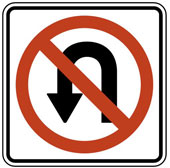



Most vehicle statutes are very specific. This definitely works to your advantage. The fact they are specific as to what constitutes a violation, makes it often times possible to find an element of the law you have not broken.
Let's take the vehicle code for U-turn traffic tickets as an example.
Just about every state has the same vehicle or traffic code regarding U-turns. Although worded differently, they all basically say the same thing.
A typical U-turn vehicle code is as follows:
You'll want to rip this code apart, piece-by-piece. Use slashes to separate the different elements of the code.
Once you have placed slashes in between the different elements of the code, it is time to completely dissect the code.
Now, just look at it and really study it for about a minute. What does it say?
Were you in a residential district? Be careful with this one. Just because there were houses in the area does not necessarily mean it was a residential district. I've seen plenty of homes in an area zoned commercial. Check with your city's engineering department usually located at your local City Hall.
Did you really make a U-turn? For instance, pulling into a parking lot or drive way and then going in the opposite direction is not a U-turn.
Were there any other vehicles approaching?
Were they within 200 feet (12 car lengths) of your vehicle?
Were you at an intersection when the violation occurred?
I think you get the idea. Continue on with the remaining elements and try to find some more you have not violated. The more the better. This is how to beat a u turn traffic ticket.
Also, take a quick look at your ticket and see what the officer has written down. For instance, if he wrote the traffic as being light that day, you may convince the judge there were no vehicles approaching, or at least not within 200 feet of your car.
If you can, your ticket should be dismissed.
This technique of word-by-word reading of vehicle codes not only applies to U-turns, but most any other type of violation including running red lights, not coming to a complete stop at a stop sign, failure to yield and illegal left or right turns. Just about everything except speeding.
This is the same method lawyers use when defending a client. It's extremely effective, straight forward, simple and it works!
Many cops are not familiar with the exact wording of traffic laws. They may know it is illegal to do something, but may not know some of the exemptions involved with the law.
More traffic ticket defenses below...
Home l SiteMap l Articles l Beat a Speeding Ticket l Contact
DISCLAIMER: WWW.TRAFFICTICKETSECRETS.COM IS NOT DISPENSING LEGAL ADVICE AND IN NO WAY REPRESENTS ANY INFORMATION OFFERED AS LEGAL ADVICE. NO LEGAL ADVICE IS OFFERED FROM THIS SITE OR THE ACCOMPANYING LITERATURE IN ANY WAY, SHAPE OR FORM. YOU SHOULD CONSULT A QUALIFIED ATTORNEY BEFORE MAKING ANY LEGAL DECISIONS. THE INFORMATION PROVIDED IS JUST THAT... "LEGAL INFORMATION".
Copyright © - www.TrafficTicketSecrets.com - All Rights Reserved
Unauthorized duplication or publication of any materials from this Site is expressly prohibited.